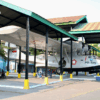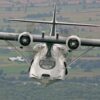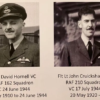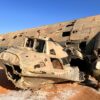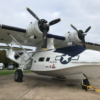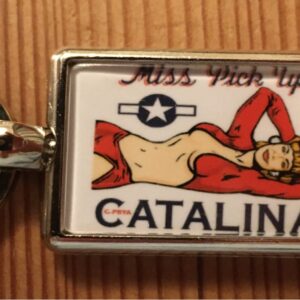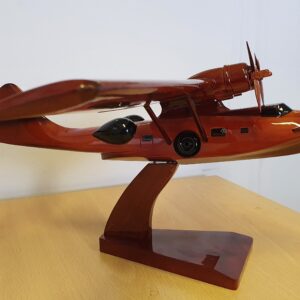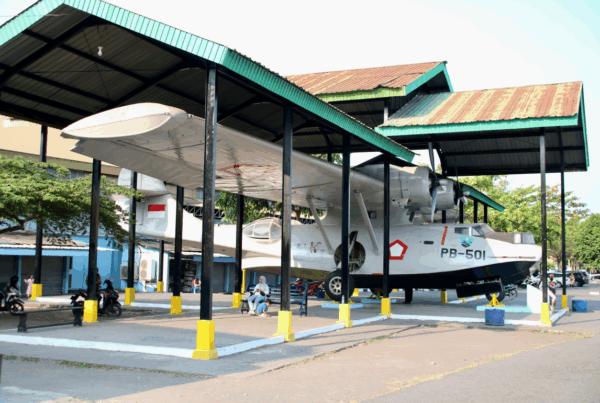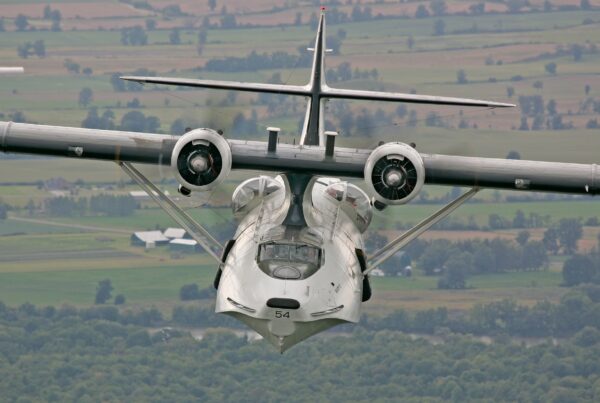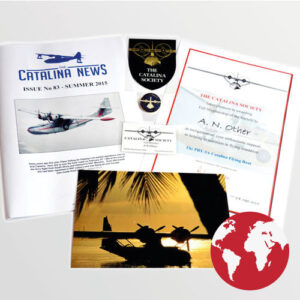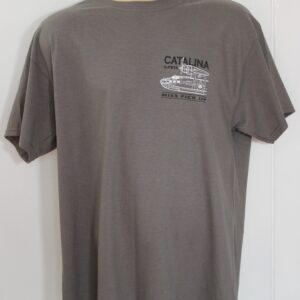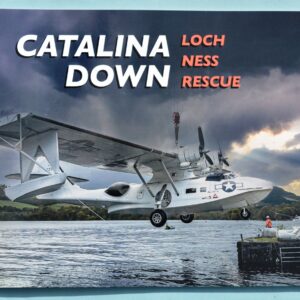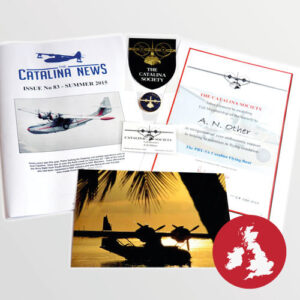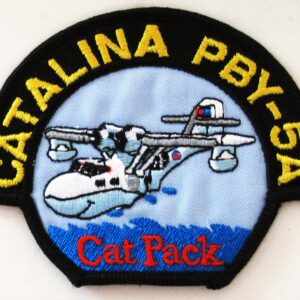There never seems to be any let-up in world-wide Catalina even though the number of airworthy examples is currently at its lowest level for many years. My detailed list of Catalina survivors may be downloaded from the Catalina Society website – look for the Survivors List tab.
There is exciting news from Australia, rapidly becoming the Catalina centre of the world! Following a failed auction offer on eBay last Spring, the future of PBY-5A N7238Z, a long-term and rapidly deteriorating resident of San Juan, Puerto Rico, looked bleak. However, the Rathmines Catalina Memorial Park Trust (RCMPT) stepped in and negotiated a purchase with the vendors. The Tirri family accepted an offer of US$20,000 and work started very quickly to dismantle the salt-laden airframe. Despite occasionally adverse weather, this task was accomplished by the Park Trust team and the Catalina started its long sea journey to Australia via the USA in August. John Richard, one of the RCMPT Trustees tells me that the first container load of parts including engines and the tail unit were due to arrive in Australia at the very end of September with the hull and main wing sections scheduled to depart san Juan at around the same time. The RCMPT intends to use the Catalina as the centre-piece for its proposed hangar and museum development at the old RAAF flying boat base at lake Macquarie, Rathmines and, eventually, it is hoped that the Catalina Flying Memorial Limited (CFML) PBY-6A Catalina VH-CAT, currently being worked on at Bankstown, Sydney, will be made airworthy and make Rathmines its base too. In the meantime, fund-raising activities continue and November 9th will see this year’s Rathmines Catalina Festival take place. The airworthy HARS PBY-6A VH-PBZ will be appearing again – last year it landed on the lake and taxied up the old hard-standing in front of an ecstatic crowd.
HARS has been in the news for other reasons too. It recently took delivery of two airworthy P&W R-1830 engines previously installed on the PBY-6A VH-EAX owned by the Qantas Founders Museum and, in return, provided two restored examples for use as static exhibits. The latter were attached to the nacelles, shrink wrapped and transported to Longreach in Queensland for installation on VH-EAX which is being brought up to display condition after its long delivery flight from Spain a year or so ago.
Chile has had an association with Catalinas since World War Two and even after its air force stopped using them, a number continued in use there with commercial operators as passenger carriers and water bombers. In addition to the static airframe in the Museo Nacional Aeronautico y del Espacio at Los Cerrillos, Santiago there is still a nominally airworthy example at SCL, Santiago’s International Airport. This is CC-CDT and my correspondent Álvaro Romero tells me that earlier this year it was re-painted in colours to represent the Chilean Air Force aircraft 405 Manu-tara, the same scheme as that on the museum aircraft! The change of livery is linked to some film work and perhaps this will result in CC-CDT flying again. Let’s hope so! Thus far, it has been used in taxying shots only. As an aside, some time before the re-paint, CC-CDT was used in a heavily CGI’d commercial for Procter & Gamble’s Mr Cleancleaning products! It is about half-way through the commercial at http://shortformblog.com/post/53648080713/mr-clean-origin-story.
The US Federal Aviation Administration continues to trawl through the USCAR (its civil register) to weed out old allocations. Recent Catalina changes include the ex-USAAF OA-10A Catalina N57875, originally 44-33954. Recovered from its wartime crash site at Dago Lake in the wastes of Alaska by helicopter several decades back, it was placed on the USCAR but there does not seem to have ever been an intention to restore it to airworthy condition. Work continues to bring it up to static display standard by the Alaska Aviation Heritage Museum in Anchorage but, like N4934H, its registration was cancelled as ‘expired’ on March 6th this year. Another change related to the one-time RCAF Canso A N4934H which was cancelled from the register as ‘expired on June 7th. It had originally been cancelled on September 11th, 2011 so the significance of this latest paper exercise is not known. The aircraft itself is currently held by the Historic Aviation Museum, at Tyler in Texas. More recent ‘clearing up’ cancellations includePBY-5A N6456C, originally revoked on December 14th, 1970 and formally cancelled on August 6th, 2013;PBY-5A N68756 (registered as a Model 28-5ACF) which was cancelled on August 21st; PBY-5A/Model 28-5ACF (but actually a PBY-6A) N6454C which crashed at Klamath Falls, Oregon as long ago as October 4th, 1965 but was only formally cancelled as expired on August 6th and PBY-6A N6465C cancelled on August 6th. Of these last four, only N68756 has been seen in the recent past and its hull now resides at Pima Air Museum in Arizona where one day it will be rebuilt as a static exhibit using the hulls of several other derelict Catalinas.
Now some news snippets from Canada. The RCAF Canso A 11087 has been in the collection of the Canada Aviation & Space Museum at Rockcliffe, Ontario since 1964. It has been kept indoors but in recent years has never been on proper public display despite the type’s enormous significance in Canadian aviation history. A recent enquiry by my colleague J-Christophe-Polet resulted in a reply from the museum’s conversation division to say that there are asbestos issues with the airframe. Apparently, the binding agent around the asbestos in the original heater system has deteriorated and the asbestos itself has become very friable and ‘airborne’ so the airframe has been sealed and access restricted. This will no doubt mean that any chance of public display is unlikely in the near future.
Meanwhile, there is an internet report that another Canso A, CF-NJL, has been sold. It is just a rumour, posted in August on The Aviation Forum and no further information has appeared. CF-NJL has been owned for decades by David Dorosh and has been stored inside a hangar at Gananoque Airport, occasionally being towed outside for fresh air and engine runs. Although not in stock condition, it is nonetheless something of a ‘time machine’ having had no further conversion work carried out on it since being surplussed by the RCAF in 1961.
Here in the UK, the ongoing restoration of PBY-5A N423RS at Biggin Hill in Kent has run into a problem and the aircraft, sans outer wing sections, has been wheeled outside from the hangar within which work was being carried out. According to Edwards Brothers Aviation, the company carrying out the overall project, it has been found that at some point in the aircraft’s commercial career, holes have been drilled into the wing’s lift struts and steel bolts inserted. The result is corroded aluminium in the struts. The damaged struts can be cosmetically repaired for a static exhibit but are not suitable for use on an airworthy aircraft so the search is on for a swap. This will presumably delay the project’s completion and the previously stated intention to fly ‘RS to the USA for its new owners.
Lastly, another correspondent, Tom Singfield, tells me that on a recent aviation-related visit to Colombia, he noted that the dismantled remains of PBY-5A FAC619, once of the Fuerza Aérea Colombiana still sits in the scrap area of the Madrid Air Force Base at Bogota after many years of residency.

PBY-5A N7238Z dismantled at San Juan, Puerto Rico and ready for shipping to a new life in Australia, August 2013 Photo: Penny Furner

CC-CDT photographed at Santiago International Airport recently in her ‘new’ FACh colour scheme representing serial number 405 Manu-tara Photo: Parragué Ltda

PBY-5A N68756 has recently been formally cancelled from the FAA register but its demise started some years ago in Texas as seen in this photo Photo: Larry Preece


